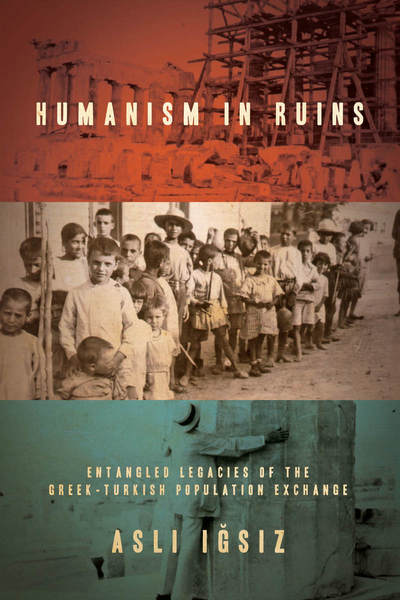
Humanism in Ruins: Entangled Legacies of the Greek-Turkish Population Exchange by Asli Iğsız

The settlement of the embittered Greek-Turkish conflict of 1919–1922 constitutes a dubious landmark for international law, as well as social and political history of the region. The swiftness and comprehensiveness of the settlement was hailed by some as a sure indicator of the success of the Lausanne Peace Treaty of July 23, 1923, which secured the international recognition of the Republic of Turkey as an independent nation-state and set the legal terms of minority protection in the post-Ottoman era across Asia Minor. Asli Iğsız’ recent book Humanism in Ruins: Entangled Legacies of the Greek-Turkish Population Exchange,is the latest addition to the growing literature of critical analysis of the Greek-Turkish population exchange and without a doubt debunks the myth that it was a win-win solution and a clear achievement once and for all. The book is divided into three parts and the debates concentrate on a variety of inter-linked subjects, amongst which humanism and its discontents, biopolitics, genealogy, and historicist humanism, (and a grounded critique of liberal multiculturalism and unity in diversity thesis) stand out.
Each part is strong enough to be a stand-alone treatise and an invitation for engaged and committed practices of cultural analysis. The introduction and the conclusion, namely a brief debate on the Greek-Turkish population exchange and a statement on the direction of cultural analysis in the age of secularism, bookend these nuanced debates on humanism that constitute the main body of the work. Iğsız is unequivocal in her consideration that segregative biopolitics and humanist cultural dictates steeped in racialized hierarchies of civilization are interrelated at multiple levels, with broader implications for the configurations of alterity in post-colonial and post-imperial polities (17). The author is heavily invested in the marking of the categorization, classification, exploitation, dispossession, and reconfigurations of the “human” as a means of displaying the very ruins of modernity when they are paraded as the success of the new nation-states across South Eastern European landscapes. Accordingly, tracing the legacies of biopolitics via studies of cultural heritage primarily at a microscale is no panacea to the ills caused by denial of rights, histories, or even memories of what once was. With no discussion of appropriation, histories of violence, or anything that cannot fit into the cleansed versions of what culture stands for, radical historical re-contextualization of “landmark events,” such as the Greek-Turkish population exchange constitutes a necessary new beginning for this seemingly old discussion.
The final decade of the Ottoman Empire indeed was marked by massive uprooting of a whole range of ethnic and religious communities in the Balkans and Asia Minor. These forced migrations were caused exclusively by political developments, nation-building plans and by vagaries of multiple wars, affecting in excess of three million people. They also formed the final stage in a process through which Muslim communities belonging to various ethnic and linguistic groups had fled from the former Ottoman domains around the Black Sea and in South-Eastern Europe to Asia Minor. These refugees and deportees who were almost exclusively Muslim began to see the creation of a homeland in Asia Minor with a solid Muslim majority as a political priority. In conjunction, over a million Greek Orthodox and Armenian Christians were driven from their historical homes in Asia Minor and, in the case of the Armenians, many were massacred. After World War I, the Ottoman Empire was then engaged in a prolonged armed struggle that took place between Muslims on the one hand and Armenians and Greeks on the other over the possession of Asia Minor. It was in this convoluted context that the decision was taken by state dignitaries and parties to the Lausanne treaty to exchange minority populations between Turkey and Greece. Across the region, the emigration of ethnic and religious minorities, whether voluntary or involuntary, became a commonly occurring and almost naturalized practice. It is true that after the collapse of the Ottoman Empire in the early twentieth century, modern Turkey still carried the legacy of a multi-ethnic, multi-religious diversity in which its Armenian, Greek and Jewish communities had official minority status based upon the 1923 Treaty of Lausanne. However, throughout the twentieth century, as Iğsız meticulously documents while also providing a rich political and cultural context, Turkey’s remaining non-Muslim minority populations underwent yet another mass emigration experience during which thousands migrated to various countries around the globe never to return. Of importance to Iğsız’ manuscript is not just the disappearance of whole pillars of the society with seemingly no trace. The author is keen to delve into the glorification of culture and identity in the decades following the population exchange in the global discourse of culture and authenticity, as exemplified by her extended discussion UNESCO and innovative transformations of racism with the advance of capitalism. In many ways, this latter effort is what makes this volume so unique.
In earlier seminal works on the Greek-Turkish population exchange, such as Onur Yildirim’s (2007) Diplomacy and displacement: reconsidering the Turco-Greek exchange of populations, 1922–1934and Umut Özsu’s (2015) Formalizing Displacement: International Law and Population Transfers, sovereignty and international humanitarian law rather than culture were highlighted as theoretically troubled and politically problematic concepts. Drawing from a mix of personal narratives, cultural critique, post-doctrinal analysis of humanism, and ethnographic mapping of citizenship practices, Iğsız carries the population exchange to a transnational setting with observable theoretical elegance. In this regard, although the study at hand is not a comprehensive and factually grounded narrative of the very exchange, it never claims to be one in the first place. While previous work shed serious doubt on the success paradigm attributed to this event and offered a critique of official versions of the history of the exchange, Iğsız’ work brings the huge and often devastating implications for the lives of ordinary people of this event further to the fore. In this sense, she joins the ranks of intersectional analysis of the cleansing impulse that operated across the region as discussed by Nergis Canefe’s (2003) Foundational Paradoxes of Balkan Nationalisms-Authenticity, Modernity and Nationhood, Esra Ozyurek’s (2007) The politics of public memory in Turkeyand Leyla Neyzi’s (2008) Remembering Smyrna/Izmir: shared history, shared trauma.In terms of intellectual history, Iğsız thus in part belongs to a generation of scholars whose starting premise is that national identification practices and nationalist historiography in Turkey have almost singularly focused on erasing differences and diversity and configuring a homogeneous and semi-fictive nation. However, she is equally weary of people’s engagement with the past as symptomatic of nostalgia for a traceable self-identification through family histories and geographies of presumed origins. Rather, she has a keen eye for depicting administered forgetting of the past despite the opening up of a space in the public domain to reconsider the past and to rewrite history at an individual level. That is the very point where her disenchantment with the liberal logic of multiculturalism comes into play. Iğsız is unapologetic in turning her gaze almost immediately to current segregative policies such as walls, partitions, and formal and informal apartheid regimes, all purportedly enacted as a means to achieve peace and attempting to mapthe links between liberal discourses on peace and the legacies of this particular episode of forced migration. She makes it clear that the call of liberal humanism, with its ahistorical and dangerously skewed emphasis on some shared humanity, fails to confront an underlying racialized logic of the modernist project of nation-building and sustenance.
Supported by Athens and Ankara, and implemented largely by the League of Nations with the aid of local bureaucrats, military and diplomats, the Greek–Turkish population exchange did not only uproot and forcibly resettled hundreds of thousands of civilians who were not an active party in the war. The aim was not to channel self-determination claims, or install protective mechanisms for minorities, otherwise familiar features of the Allies’ management of imperial disintegration in Europe after 1919. Nor was it to restructure a given economy and society and generate an entirely new legal order in the process as has been the case with the work of the Mandate System in the interbellum. Instead, the goal was to deploy a unique legal mechanism for re-dividing imperial lands, reshaping national identities, and unleashing new processes of capital accumulation. Though not mentioned in Iğsız’s work, there were at least four sets of movements – three of which never truly made it past their planning stage – that have conventionally been deemed precedents to the Greek-Turkish exchange and fortified the idea of its possibility. These are discussed in one of the earliest accounts of forced migration in the region, S. P. Ladas’ The Exchange of Minorities: Bulgaria, Greece and Turkey (1932). Each of these experiences – the first projected for Bulgaria and Turkey in 1913, the second planned for Greece and Turkey in 1914, the third and most comprehensive implemented between Greece and Bulgaria in 1919, and the fourth designed for Greece and Turkey again, this time in 1919 – laid the legal and logistical groundwork for the much more ambitious 1923 exchange. In addition, though traditionally understood to typify a different kind of phenomenon, the Armenian exodus was co-ordinated by many of the same Turkish policy makers and driven by much of the same legal strategies and methods of demographic engineering. How this particular population exchange is incorporated into the carefully crafted biographies of Greece and Turkey is a question directly relevant to the mnemonic nature of historiography at a national level. AsIğsız’s work readily testifies, how this memory is formed and continually reproduced is becoming an increasingly crucial question, not only for scholars wishing to revise the history of the exchange, but also for the affected societies at large and beyond. Comprehending the multiple meanings of this epochal event and unearthing the interconnectedness of not just memory and history, but culture, politics, and nation-building as the underbelly of the ethos of modernity above and beyond the constraining context of “competing nationalisms in the Ottoman Empire” is to be congratulated in earnest.
Nergis Canefe is a scholar trained in the fields of Political Philosophy, Forced Migration Studies and International Public Law with special focus on Human Rights and state-society relations. She has over twenty years of experience in carrying out in-depth qualitative research with displaced communities and teaching human rights and public law globally. Her research experience includes working with the Muslim and Jewish Diasporas in Europe and North America, refugees and displaced peoples in Turkey, Cyprus, India, Uganda, South Africa, Bosnia and Colombia. She worked as the Associate Director of Center for Refugee Studies, York University between 2008-2013. Currently she is an executive committee member of the IASFM (international association for the study of forced migration).
Humanism in Ruins: Entangled Legacies of the Greek-Turkish Population Exchange
By Asli Iğsız
Publisher: Stanford University Press
Hardcover/ 344 pages/ 2018
ISBN: 9781503606357
To read more book reviews click here.
Published on October 22, 2019.
Canefe, N. (2003). “Foundational Paradoxes of Balkan Nationalisms-Authenticity, Modernity and Nationhood.” Turkish Review of Balkan Studies 8: 107
Neyzi, L. (2008). “Remembering Smyrna/Izmir: shared history, shared trauma.” History & Memory 20, no. 2 : 106-127
Özsu, U. (2015). Formalizing Displacement: International Law and Population Transfers, Oxford University Press.
Ozyurek, E. ed. (2007). The politics of public memory in Turkey, Syracuse University Press
Yildirim, O. (2007). Diplomacy and displacement: reconsidering the Turco-Greek exchange of populations, 1922–1934, Routledge




